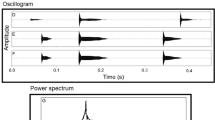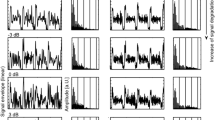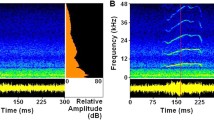Summary
During the spawning period, male grass frogs (Rana temporaria L.) frequently produce short and long territorial calls in addition to mating calls. The calls differ in mean pulse number, duration, and pattern of amplitude modulation. Experiments in which recorded natural calls are played back reveal that male grass frogs are capable of discriminating the different conspecific calls. A male frog stimulated by mating calls always responds by producing mating calls in greater numbers (Fig. 3). Territorial calls presented at low intensity also cause an increase in the mating-call rate (Fig. 4), but at high intensity they clicit territorial calls and turning toward the loudspeaker. A combination of short and long territorial calls was especially effective in eliciting the phonotaxis response. As play-back experiments with simulated calls show, the carrier frequency and the pulse repetition rate are particularly important cues for recognition of conspecific calls (Fig. 5). A simulated call with a 400-Hz carrier frequency (the dominant frquency of the mating call) is just as effective as the natural call with the complete frequency spectrum (Fig. 3), whereas a 1100-Hz simulated call is ineffective (Fig. 5). The chief factors in discrimination among the conspecific calls are the call repetition rate and probably the amplitude and frequency modulation. Changes in the duration of the calls had little effect (Fig. 6). The available evidence suggests that the mating call has a reciprocally stimulating action on males in a chorus, whereas the territorial calls experess aggressiveness and give warning to other males.
Similar content being viewed by others
References
Bogert CM (1960) The influence of sound on amphibians and reptiles. In: Lanyon WE, Tavolga WN (eds) Animal sound and communication. Am Inst Biol Sci, Washington, DC, pp 137–320
Brzoska J (1981) Der elektrodermale Reflex auf akustische Reize beim Grasfrosch Rana t. temporaria (L.). Zool Jahrb Physiol 85:66–82
Brzoska J (1982) Vocal response of male European water frogs (Rana esculenta complex) to mating and territorial calls. Behav Processes 7:37–47
Brzoska J, Obert H-J (1980) Acoustic signals influencing the hormone production of the testes in the grass frog. J Comp Physiol 140:25–29
Brzoska J, Walkowiak W, Schneider H (1977) Acoustic communication in the grass frog (Rana t. temporaria L.): calls, auditory thresholds and behavioral responses. J Comp Physiol 118:173–186
Brzoska J, Schneider H, Nevo E (1982) Territorial behavior and vocal response in male Hyla arborea savignyi (Anura: Amphibia). Isr J Zool 31
Capranica RR (1966) Vocal response of the bullfrog to natural and synthetic mating calls. J Acoust Soc Am 40:1131–1139
Emlen ST (1968) Territoriality in the bullfrog, Rana catesbeiana. Copeia 1968:240–243
Fellers GM (1979) Aggression, territoriality and mating behaviour in North American treefrogs. Anim Behav 27:107–119
Flindt R, Hemmer H (1972) Untersuchungen zur Reaktion von Bufo calamita und Bufo viridis auf arteigene Rufe. Biol Zentralbl 91:597–600
Gambs RD, Littlejohn MJ (1979) Acoustic behavior of males of the Rio Grande leopard frog (Rana berlandieri): an experimental analysis through field playback trials. Copeia 1979:643–650
Gelder JJ van, Evers PGM, Maagnus GJM (1978) Calling and associated behaviour of the common frog, Rana temporaria, during breeding activity. Anim Ecol 47:667–676
Günther R (1969) Paarungsrufe und reproduktive Isolations-mechanismen bei europäischen Anuren der Gattung Rana (Amphibia). Forma Functio 1:263–284
Jenssen TA, Preston WB (1968) Behavioral responses of the male green frog Rana clamitans, to its recorded call. Herpetologica 24:181–182
Littlejohn MJ (1977) Long-range acoustic communication in anurans: an integrated and evolutionary approach. In: Taylor DH, Guttman SI (eds) The reproductive biology of amphibians. Plenum Press, New York, pp 263–294
Loftus-Hills JJ (1971) Neural correlates to acoustic behaviour in the Australian bullfrog Limnodynastes dorsalis (Anura: Leptodactylidae). Z Vengl Physiol 74:140–152
Lörcher K (1969) Vergleichende bio-akustische Untersuchungen an der Rot- und Gelbbauchunke, Bombina bombina (L.) und Bombina v. variegata (L.). Oecologia (Berl) 3:84–124
Narns PM, Capranica RR (1978) Communicative significance of the two-note call of the trefrog Eleutherodactylus coqui. J Comp Physiol 127:1–9
Paillette M (1970) Conditions biophysiques du declenchement du signal sonore chez Hyla meridionalis (Amphibien Anoure). Terre Vie 24:251–300
Sachs L (1978) Angewandte Statistik. Springer, Berlin Heidelberg New York
Schmidt RS (1964) Hearing and responses to calls in anurans. Behaviour 23:280–293
Schneider H (1973) Die Paarungsrufe einheimischer Ranidae (Anura, Amphibia). Bonn Zool Beitr 24:51–61
Schneider H (1982) Phonotaxis bei Weibchen des Kanarischen Laubfrosches, Hyla meridionalis. Zool Anz (Jena) 208:161–174
Wells KD (1977) The social behaviour of anuran amphibians. Anim Behav 25:666–693
Wells KD, Greer BJ (1981) Vocal responses to conspecific calls in a neotropical hylid frog, Hyla ebraccata. Copeia 1981:615–624
Whitney CL (1980) The role of the “encounter” call in spacing of Pacific tree frogs, Hyla regilla. Can J Zool 58:75–78
Wiewandt TA (1969) Vocalization, aggressive behavior and territoriality in the bullfrog, Rana catesbeiana. Copeia 1969:276–285
Author information
Authors and Affiliations
Rights and permissions
About this article
Cite this article
Walkowiak, W., Brzoska, J. Significance of spectral and temporal call parameters in the auditory communication of male grass frogs. Behav Ecol Sociobiol 11, 247–252 (1982). https://doi.org/10.1007/BF00299301
Received:
Accepted:
Issue Date:
DOI: https://doi.org/10.1007/BF00299301




